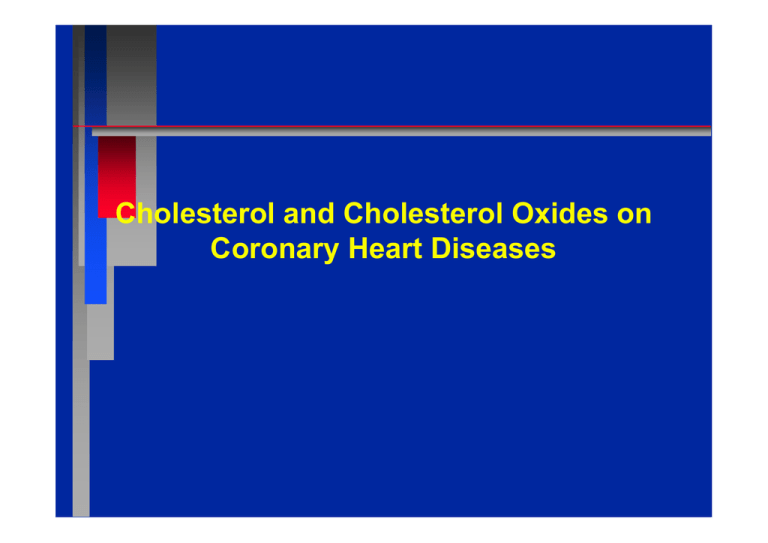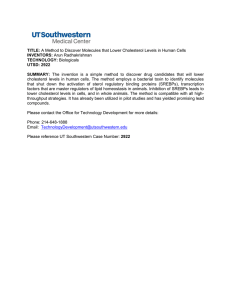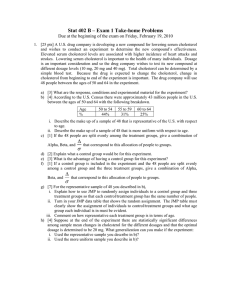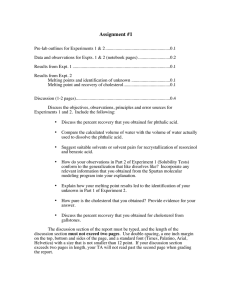Cholesterol and Cholesterol Oxides on Coronary Heart Diseases
advertisement

Cholesterol and Cholesterol Oxides on Coronary Heart Diseases Trends in egg consumption in U.S. and the reason A. Egg Consumption: - 403 in 1945 - 234 in 1993 (176 Table eggs, 58 Processed eggs) - 256 in 2004 B. Major concerns: Cholesterol and Fat in eggs - Cholesterol in egg: 213 mg/large egg (1989) 30% of Yolk - Cholesterol in meat: 70-80 mg/100 g How Cholesterol is Used in the Animal Body 21 CH3 22 26 24 CH3 20 18 CH3 12 19 CH3 16 27 CH3 14 15 9 1 10 2 8 5 3 25 17 13 11 23 4 OH Vitamin D 7 6 Cholesterol Cell Membrane Hormones Bile Skin Cholesterol and CHD: Theories - Plasma lipid theory - Response-to-Injury hypothesis: Lipid and cholesterol oxidation products cause injury - Combined “Lipid” and “Injury” Hypothesis Arteriosclerosis and CHD Atherosclerosis: general term for a condition characterized by thickening, hardening, and loss of elasticity of the walls of the blood vessels. CHD: condition that results when the coronary arteries are narrowed or occluded, most commonly by atherosclerotic deposits of fibrous and fatty tissue. Coronary artery disease is the most common underlying cause of cardiovascular disability and death. Plasma lipid theory (Infiltration theory) The infiltration of LDL cholesterol into the wall of an artery is the major factor in the infiltration and progression of atherosclerotic plaques. Cholesterol plays a pivotal role. Plasma lipid theory (Infiltration theory) - Anitschew (1913): High frequency atherosclerosis in rabbits when fed cholesterol - Feeding 2% cholesterol diet increased serum cholesterol level by 90 folds and increased atherosclerotic lesion (Langner and Bement, 1985). - Epidemiological Studies: High serum Cholesterol is related to atherosclerosis - Intervention reduced atherosclerosis: Cholestryamine (increase the rate of bile excretion) - High cholesterol induced atherosclerosis but the response varied among rabbits (Duff et al., 1957) - LDL receptor theory of Goldstein and Brown (1976): familial hypercholesterolemia Does dietary cholesterol raise serum cholesterol? - At very high level of intake (> 1000 mg per day): yes. Because physiological compensation mechanisms (decreased synthesis and absorption of Cholesterol increased excretion via bile salts) are not good enough to maintain SC level - At 500 - 800 mg level: 70% can maintain homeostasis by the compensation mechanisms. Approximately 30% increased Sc level temporarily and went back to normal. - Only U.S. has dietary cholesterol level in a dietary guideline Response-to-Injury Hypothesis - An injury to the endothelium is the initiating event in atherogenesis - Reinterpretation of cholesterol study Questions on the purity of cholesterol (Taylor et al., 1979) - USP grade cholesterol was contaminated with cholesterol oxidation products (COPS) - Epidemiological study: Indian immigrants to London Biological effects of cholesterol oxides - Atherogenicity - Angiotoxicity - Cytotoxicity - Mutagenecity - Inhibition of enzyme activities: HMGCoAR Cholesterol Oxides 7α-OH or 7β-OH cholesterol 5,6α- or 5,6β-epoxides Cholestanetriol 7-keto cholesterol 5 α-hydroperoxycholesterol Endothelial cell injury: Mechanically and chemically - Hypertension - Plasma LDL: familial and diet related - Toxins: COPS, virus, and drugs - Pure cholesterol was not atherogenic nor angiotoxic in spite of being able to induce hypercholesterolemia - Each COPS were angiotoxic and atherogenic: Cholestan triol, 25-hydroxycholesterol are the most potent atherogenic agents Combined “Lipid” and “Injury” Hypothesis - Endothelial injury by Lipid Oxidation Products and then plaque accumulation by LDL-cholesterol - COPS are initiators of atherosclerosis - Cholesterol is involved in plaque deposition - Cholesterol deposition is merely a secondary process preceded by a complex series of pathological changes involving the interplay of endothelial cells, macrophages, platelets, growth factors, chemotactic factors, lipoproteins, and foam cells. Angiotoxicity and cytotoxicity - Explain their role as initiators of atherosclerotic lesions - Endothelial cell damage initiates the complex series of pathological changes leading ultimately to plaque, wall thickening, and lumen narrowing Atherosclerotic cascade • Wound by toxin or hypertension (right brachiocephalic artery is more susceptible) • Release of chemokines, accumulation of platelets for healing • Monocytes cross the endothelial cell layer and scavenge oxidized LDL • Foam cell formation and then fatty streak • Foam cells secrete chemokines, and platelets and foam cells secrete growth factors Atherosclerotic cascade • More monocytes/macrophages and Tlymphocytes accumulate • Swelling and damage of endothelial cells by the free radicals and smooth cell growth • Cell rupture and platelets aggregation as a process of wound healing • LDL, cholesterol esters, lipid, collagen, calcium deposition • Plaque formation • Obstruct arteries and thrombosis Cholesterol Oxidation - In solid phase (crystalline cholesterol): side chain oxidation - In aqueous solution: autoxidation similar to that of other lipids - Exposure to air, heat, light and radiation accelerate cholesterol oxidation - Variety of COPS are found in foods: milk products, egg products, fish products - COPS are absorbed in intestine and transferred by LDL and VLDL Types of heat treatment on oxysterols formation in spray-dried egg mix -------------------------------------------------------------------------------------------------------------------------------------------------- Oxysterol Indirect heat (mg/g) Direct heat (mg/g) Increase (%) -------------------------------------------------------------------------------------------------------------------------------------------------- 7α-hydroxy cholesterol 7β-hydroxy cholesterol α-epoxide β-epoxide 25-hydroxy cholesterol 7-ketocholesterol Cholestantriol 1.8 1.5 21.5 1.9 1.4 2.0 11.6 7.0 18.5 50.0 37.4 5.1 37.0 13.0 289 1133 132 1868 264 1750 12 -------------------------------------------------------------------------------------------------------------------------------------------------- Missler et al. (1985, J. Food Sci. 50: 229) Oxysterols (ppm/food sample) in processed meats ------------------------------------------------------------------------------------------------------------------------------------------------- Processed Meat 25-OH 7 α-OH 7 β-OH triol ------------------------------------------------------------------------------------------------------------------------------------------------- Cooked Bratwrust Beef Franks Chicken rolls Cooked Hamburgers Cooked lean bacon Raw hamburger Turkey bologna Tr Tr Tr Tr Tr Tr Tr 820.0 98.5 Tr 72.0 Tr Tr NA Tr 34.0 Tr NA NA 36.0 NA 1335.0 Tr Tr NA Tr 1298.0 86.0 ------------------------------------------------------------------------------------------------------------------------------------------------- Higley et al. (1986, Meat Sci. 16:175) Cholesterol oxides (ppm, dry wt. basis) in the edible portions of commercial fish products Sample Lipid 7 β-OH 7-keto epoxides Triol 25-OH Salt-dried Anchovy 11.5 37.1 46.4 45.2 3.5 5.8 Northern cod 4.8 6.8 9.7 8.4 1.5 0.9 Jap. Whiting 6.8 24.5 24.9 25.0 3.4 10.7 Pacific herring 27.0 8.4 7.5 8.9 3.5 5.6 Boiled-dried Anchovy Shrimp 11.2 6.2 55.8 3.7 60.6 4.0 61.3 tr 8.5 tr 1.8 8.5 Smoked salmon 8.7 7.3 6.3 Ohshima et al. (1993, JAOCS 70:595) 5.7 2.7 4.8 Efforts to solve cholesterol problems - Use of drug: bile salt sequestrants (Cholestyramine), Nicotinic acid (decrease VLDL production), HMGCoAR inhibitor - Diet: increase n3 fatty acids and decrease saturated fat consumption - Removal of cholesterol from foods by physical and chemical methods Proposed Benefit of N-3 Fatty Acids Omega-3 fatty acids reduce: - Platelet aggregation - Serum triglycerides - Arterial spasm - Blood pressure - Serum cholesterol Pathways for Eicosanoids Synthesis Diet Body LTB4 LTC4 LTB5 LTC5 E,D LA LA AA L AA LNA EPA DHA AA E,D E,D LNA EPA EPA DHA DHA AA C PGI2 TXA2 L + EPA, DHA C PGI3 TXA3 Mechanisms of action of EPA and DHA L C LTB4, LTC4 <-------------- AA -----------------> PGI2, TXA2 L C LTB5, LTC5 <---------- EPA, DHA -----------> PGI3, TXA3 * LTB4, LTC4: increase adhesion of Leucocytes to endothelium and inflammatory effects * LTB5, LTC5: less effective than LTB4, LTC4 *PGI2: vasodilator, inhibit platelet aggregation *PGI3: help effect of PGI2 *TXA2: increase platelets aggregation, vasoconstriction *TXA3: less potent than TXA2 N3 fatty acids compete with N6 for elongase, desaturase, cyclooxygenase and lipoxigenase Possible adverse effects of high level consumption of omega-3 fatty acids - Depletion of tissue vitamin E - Increased propensity to bleed - Increased consumption of lipid oxidation products - Increased in vivo production of lipid oxidation products Effect of dietary fats on blood cholesterol and the development of atherosclerosis in rabbits Fatty acid composition (%) and peroxide values of oils used Item Myristic acid Palmitic acid Palmitoleic acid Oleic acid Elaidic acid Linoleic acid Linolenic acid Stearic acid Eicosatetrenoic acid Eicosapentanoic acid Docosahexanoic acid Other fatty acids CO FO OO HCO ----------- Fatty acid composition (%) --------------7.56 13.88 20.19 10.63 13.82 10.11 28.39 10.74 37.15 33.55 0.68 1.11 54.93 1.70 50.15 49.17 0.36 3.31 2.34 3.45 2.06 2.34 0.65 12.23 11.72 25.90 - Peroxide value (PV) --------------- meq peroxide/kg oil -------------------30.28 31.57 144.87 28.43 Abbreviations: CO, 2% fresh corn oil; FO, 2% fresh fish oil; OO, 2% oxidized oil; HCO, 2% heated corn oil. Cholesterol (CHO, 1.5 g/kg diet) Effect of various dietary oils on cholesterol content in plasma Dietary treatment NO CO FO OO HCO Feeding periods (weeks) 0 3 6 9 12 ------------------ cholesterol (mg/dL) ----------------------69.6 407.7 447.1 453.6 430.6 69.6 333.8 379.0 321.0 281.8 69.6 341.9 429.1 459.9 449.8 69.6 396.2 444.9 474.4 435.8 69.6 281.4 246.0 192.7 184.4 Abbreviations: NO, 0% oil; CO, 2% fresh corn oil; FO, 2% fresh fish oil; OO, 2% oxidized oil; HCO, 2% heated corn oil. Cholesterol (CHO, 1.5 g/kg diet) was added to all the experimental diets. Atherosclerotic lesions in aorta of rabbits fed diets containing cholesterol and different oils Dietary treatment 9 week 12 week --------------- Score of lesions ------------------NO 2.25 3.75 CO 1.00 1.50 FO 2.25 2.75 OO 1.75 3.50 HCO 1.00 1.50 Abbreviations: NO, 0% oil; CO, 2% fresh corn oil; FO, 2% fresh fish oil; OO, 2% oxidized oil; HCO, 2% heated corn oil. Cholesterol (CHO, 1.5 g/kg diet) was added to all the experimental diets. Atherosclerotic lesions in aorta of rabbits fed with different levels of dietary cholesterol Results No added oil and oxidized oil groups developed the highest degree of atherosclerotic lesions followed by fresh fish oil, and fresh corn oil and heated corn oil group had the lowest lesions. Plasma total cholesterol level was the most critical factors involved in the development atherogenic lesions in rabbit. Dietary cholesterol and oxidation status of dietary lipids had significant impact on lipid metabolism and the development of atherosclerosis in rabbits. Oxidized oils in diet accelerated the progress of atherosclerotic lesions, but polymerization of oils by heating lowered plasma cholesterol level and the development of atherogenic lesions in rabbits by inhibiting the absorption of cholesterol in guts.








